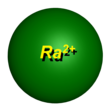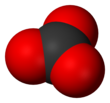
Summary
Radium carbonate is a chemical compound of radium, carbon, and oxygen, having the chemical formula RaCO3. It is the radium salt of carbonic acid. It contains radium cations (Ra2+) and carbonate anions (CO2−3). This salt is a highly radioactive, amorphous,[4] white powder that has potential applications in medicine.[5][2] It is notable for forming disordered crystals at room temperature and for being approximately 10 times more soluble than the corresponding barium carbonate - witherite.[4] Radium carbonate is one of a few radium compounds which has significantly different properties from corresponding barium compounds. Moreover, radium is the only alkaline-earth metal which forms disordered crystals in its carbonate phase. Even though radium carbonate has very low solubility in water, it is soluble in dilute mineral acids and concentrated ammonium carbonate.[6]
| |||
| Names | |||
|---|---|---|---|
| IUPAC name
Radium carbonate
| |||
| Identifiers | |||
| |||
3D model (JSmol)
|
| ||
| |||
| |||
| Properties | |||
| RaCO3[2] | |||
| Molar mass | 286.0089 g/mol[3] | ||
| Appearance | white powder[2] | ||
| insoluble[2] | |||
| Hazards | |||
| Occupational safety and health (OHS/OSH): | |||
Main hazards
|
radioactive | ||
| Related compounds | |||
Other cations
|
|||
Except where otherwise noted, data are given for materials in their standard state (at 25 °C [77 °F], 100 kPa).
Infobox references
| |||
Preparation edit
Radium carbonate can be produced by dissolving radium sulfate at elevated temperatures in concentrated sodium carbonate and subsequent removal of supernatant:[7]
- RaSO4(s) → Ra2+ + SO2−4
- Ra2+ + CO2−3 → RaCO3(s)
Because of the very low solubility of RaCO3, it will form a white precipitate.
Reactions edit
Radium carbonate can be used to produce radium nitrate and other radium salts:
- RaCO3 + 2 HNO3 → Ra(NO3)2 + H2O + CO2
References edit
- ^ "Radium carbonate - Hazardous Agents | Haz-Map". Haz-Map. Retrieved 2020-11-30.
- ^ a b c d "Radium carbonate | Article about radium carbonate by The Free Dictionary". The Free Dictionary By Farlex. Retrieved 2020-11-30.
- ^ "RADIUM CARBONATE - (7116-98-5) - Physical Properties • Chemical Properties • Solubility • Uses/Function • Reactions • Thermochemistry". Chemistry-Reference.com. Retrieved 2020-11-30.
- ^ a b Matyskin, Artem V.; Ebin, Burçak; Allard, Stefan; Torapava, Natallia; Eriksson, Lars; Persson, Ingmar; Brown, Paul L.; Ekberg, Christian (July 21, 2023). "Disordered Crystal Structure and Anomalously High Solubility of Radium Carbonate". Inorganic Chemistry. 62 (30): 12038–12049. doi:10.1021/acs.inorgchem.3c01513. PMC 10394661. PMID 37477287.
- ^ Westrøm, Sara; Malenge, Marion; Jorstad, Ida Sofie; Napoli, Elisa; Bruland, Øyvind S.; Bønsdorff, Tina B.; Larsen, Roy H. (17 January 2018). "Ra‐224 labeling of calcium carbonate microparticles for internal α‐therapy: Preparation, stability, and biodistribution in mice". Journal of Labelled Compounds and Radiopharmaceuticals. 61 (6): 472–486. doi:10.1002/jlcr.3610. PMC 6001669. PMID 29380410. S2CID 3884756.
- ^ Salutsky, M.; Kirby, H. (1964). "The Radiochemistry of Radium". Office of Scientific and Technical Information. doi:10.2172/4560824. Retrieved 2021-01-08.
- ^ Matyskin, Artem V.; Ebin, Burçak; Tyumentsev, Mikhail; Allard, Stefan; Skarnemark, Gunnar; Ramebäck, Henrik; Ekberg, Christian (5 July 2016). "Disassembly of old radium sources and conversion of radium sulfate into radium carbonate for subsequent dissolution in acid". Journal of Radioanalytical and Nuclear Chemistry. 310 (2): 589–595. doi:10.1007/s10967-016-4927-x. S2CID 100321021.




